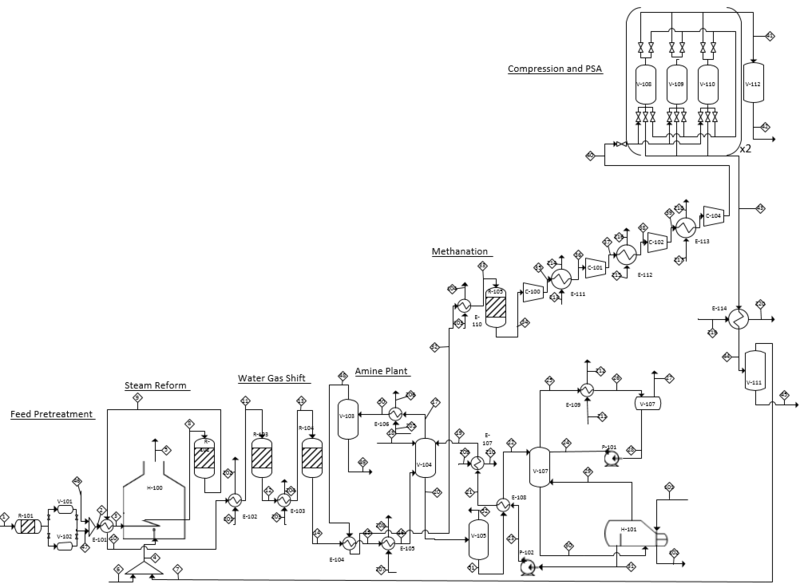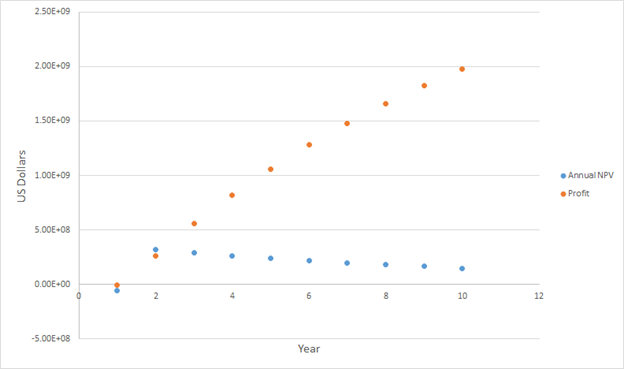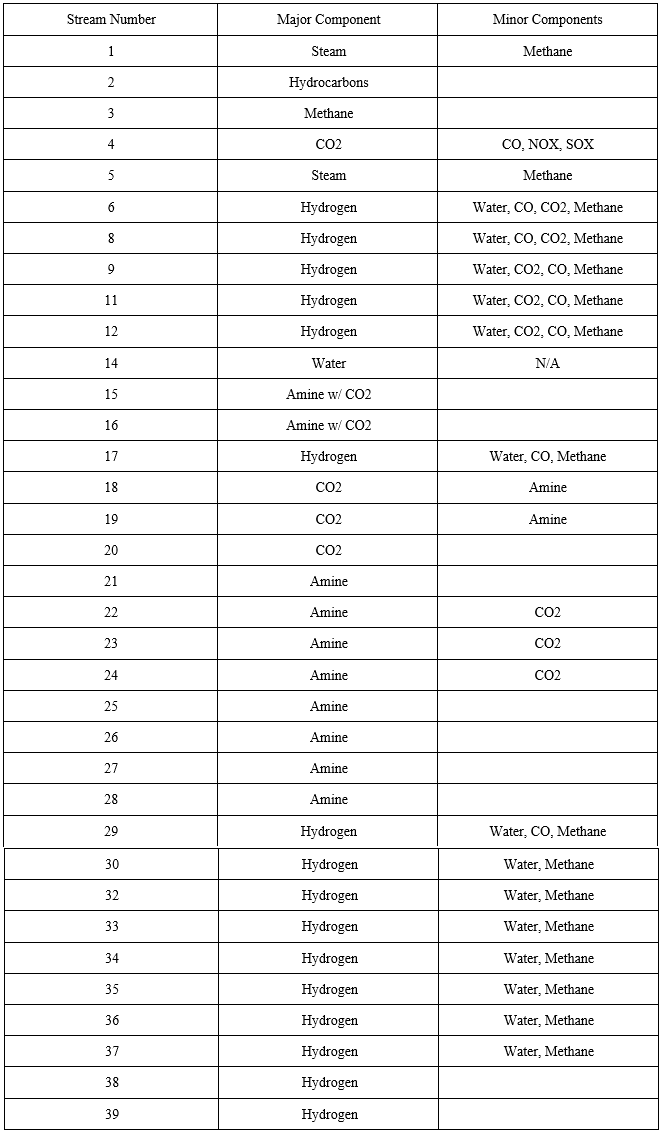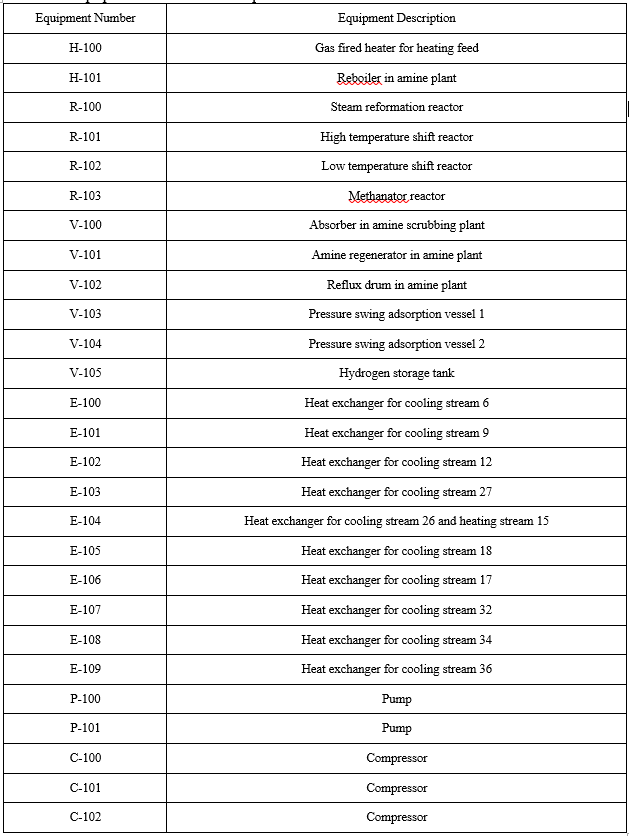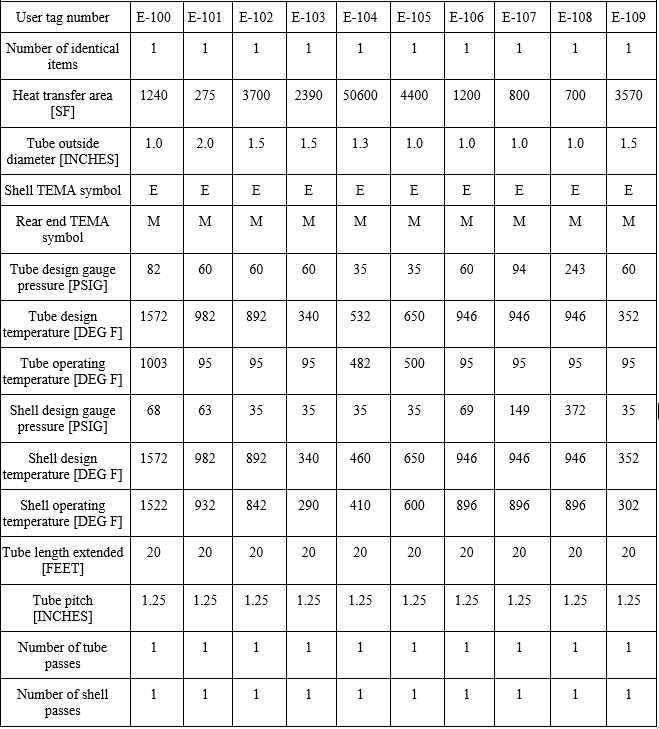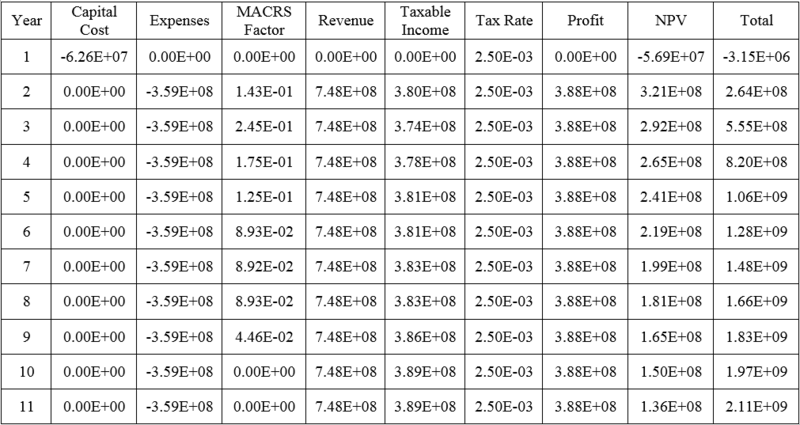Natural Gas to Hydrogen (H)
Team H Final Report
Authors: Nick Dotzenrod, Samson Fong, Vince Kenny, Matthew Leung, Matthew Nathal, John Plaxco, Spencer Saldaña, Micah Zuckerman, Erik Zuehlke
Instructors: Fengqi You, David Wegerer
Executive Summary
As environmental concerns lead many automobile makers to use alternative fuel source, hydrogen fuel cell is increasingly attractive. However, the hydrogen needed to be used in a fuel cell requires a purity of 99.999% which is purer than most applications. As a result, there is an opportunity to produce high purity hydrogen to support this potential market. In addition, the recent natural gas boom will provide a cheap feedstock for a traditional method for hydrogen production: steam reforming.
The plant is proposed to be located in Freeport, Texas to be near the East Texas Basin natural gas feedstock. It will be able to produce the hydrogen at 100 MMscfd (Million standard cubic feet per day), a relatively high capacity plant especially for such high purity hydrogen. In addition to the feedstock, the location also has a low corporate tax rate reducing annual costs.
The steam reforming process, after desulfurization, utilizes the natural gas feed by combining it with steam. The mixture is then passed through a reactor filled with catalysts, resulting in a mixture of carbon monoxide, carbon dioxide, and hydrogen. The subsequent water gas shift and separation units (amine plant) remove the impurity to result in highly pure hydrogen. Any wastewater produced will be sent for off-site treatment. The steam reforming process is industrially mature. As a result, there is no unknowns in the process as it is very well characterized. This reduces down time and risk and ensure the safety of the workers.
In order to make this process as efficient as possible, several key parameters are optimized. For instance, a large part of the operating cost is due to utility costs. As a result, heat exchangers were included and placed optimally to take advantage of the heat produced to reduce the necessary heating by a furnace. In addition, to reduce the need to treat the impure unconverted gases, they are burned as fuel. Finally, the size of the amine plant and the specific amine used are also optimized for this application of high purity hydrogen production. In addition to optimizing the process, an optimization to the process equipment has also been done. The design goal is generally to use the most industrially mature process to reduce risk of failure and maximize uptime. In addition, when there are several competing technologies, the cheapest, high-throughput capable option is selected.
The total capital cost of this proposed plant is $62.6 million. Annually, the plant is predicted to have a revenue of $748 million (assuming 360 days operation to allow for holiday vacations). In addition, the plant will cost $359 million to operate, resulting in $2.11 billion of profit after 10 years. The simple payback period is 0.161 years with a return on investment of 6.21. Financially, the cheap feedstock and process make this project highly profitable. While the economic analysis is only done for the first ten years, the plant is expected to remain in operation for 25 to 50 years.
Introduction
As the need to become less reliant on fossil fuels grows, the idea of widespread hydrogen fuel cells comes closer to being a reality. Hydrogen-fueled vehicles produce no direct pollution, making them environmentally friendly. However, fossil fuels are often used in the processes for the hydrogen production and the energy content of the produced hydrogen is less than that of the fossil fuels used (Clay et al. 2004; Actual Worldwide, 2007). To successfully implement a change to hydrogen fuel, high capacity plants must be constructed to meet increased demand. With the increased production of natural gas and the corresponding drop in price, steam reforming is a profitable method to produce hydrogen. The goal of this project is to design, optimize, and economically analyze a steam reforming process that will produce 99.999% hydrogen from a feedstock of natural gas. Waste products such as carbon dioxide, waste water, and monoethanolamine will be treated to minimize environmental impact.
Technical Approach Taken
After investigating process alternatives for each of the design stages, the final technologies chosen to achieve the specified design criteria were chosen by comparing the advantages and disadvantages as well as considering factors unique to the proposed design. The major decision was to use steam reforming to generate the hydrogen. The specific type of steam reformation chosen was conventional steam reforming due to capacity constraints. A nickel catalyst was chosen due to its low cost. To treat the CO waste, both methanation and a water gas shift were selected to ensure product purity. Amine scrubbing was picked to separate carbon dioxide from the product stream. Finally, pressure swing adsorption was chosen to handle separation of the methane from hydrogen. Several process design options were investigated to determine the most economically favorable and environmentally neutral design. The three major processes used for hydrogen production evaluated were steam reforming, partial oxidation, and autothermal reforming. Various technology options including reactor types, catalysts, and separation methods were compared to find the optimal combination of reliability, sustainability, profitability, and versatility.
The Peng-Robinson fluid package was chosen for use in the HYSYS simulation because it is ideal for describing hydrocarbon systems such as the steam methane reforming plant, where most components are gases or are nonpolar. Furthermore, Peng-Robinson is reliable over a large range of operating temperatures and pressures, which encompass those within our system. The amine plant portion of the simulation uses the amine package. This package is based on the Kent-Eisenberg model specifically designed for modeling removal of CO2 and H2S by amines. Difficulties encountered modeling adsorption processes in HYSYS lead to the use of component splitters to model the feed pretreatment and pressure swing adsorption (PSA) steps.
Site Conditions
The proposed plant will be located in Freeport, Texas, a port city in Brazoria County. Texas was chosen as the site for the plant because of its lack of corporate and individual income taxes as well as its low sales and property taxes. The sales tax rate in Freeport is 8.25% and the property tax rate is approximately 0.5%. Furthermore, the presence of the Dow Chemical Company’s Texas Operations facility in Freeport ensures that the proper utilities infrastructure will be available. Texas was rated as the best state for business in 2014, which further motivated the decision to locate the plant there. The climate of Freeport is classified as humid subtropical. This ensures continuous production with little climate effects on the plant.
Steam Reforming Process
The pre-treatment zone desulfurizes the hydrocarbon feed. Then, it is combined with superheated process steam. Afterwards, this mixture is heated and passes through reformer tubes filled with catalyst (Hydrogen Production, 2004). The reformer tubes are also heated which causes the hydrocarbon and steam mixture to react, yielding carbon monoxide, carbon dioxide, and hydrogen (Steam Reforming, 2014). The water gas shift then converts the carbon monoxide to carbon dioxide and generates hydrogen. The plant is normally operated with a higher steam content than required to prevent elemental carbon from being deposited in the catalyst bed (Steam Reforming, 2014). The pressure swing adsorption will isolate the hydrogen desired from any residual gases that are later used as fuel. Figure 1 below shows the process flow diagram of the process. The stream and vessel number descriptions are found in Appendix A.
Process Flow Diagram
Process Alternatives
Three primary techniques are used to produce hydrogen from a hydrocarbon source, such as methane. The techniques are: steam reforming, autothermal reforming, and partial oxidation. Each of these techniques has advantages and disadvantages which must be considered in choosing a final design.
- Steam reforming
- Advantages: industrially mature, no oxygen needed, lowest process operation temperature
- Disadvantage: large volume of air emissions
- Autothermal reforming
- Advantage: low methane slip
- Disadvantages: requires air/oxygen, little commercial experience
- Partial oxidation
- Advantages: no catalyst needed, needs less desulfurization, low methane slip
- Disadvantages: high process temperatures, process has high a degree of complexity, poor hydrogen to carbon monoxide ratio
Steam reforming is the most appropriate technique for the proposed design due to its high degree of industrial maturity and safe operating conditions. Although partial oxidation and autothermal reforming each have distinct advantages, the lack of maturity for both of these processes would add a high degree of risk to the overall plant design. Furthermore, the lower operation temperature of steam reforming will result in a safer process (Holiday et al. 2007).
The five methods of steam reforming that would provide the necessary purity for hydrogen cars are the conventional box method, conventional can method, the compact steam methane reformers, plate-type steam methane reformers, and membrane reactor steam reforming.
- Conventional box steam reforming
- Advantages: Conventional reforming can handle a large throughput such as the 100 MMscfd. The desired 99.99% purity is achieved after the water-gas shift and pressure swing adsorption (Ogden, 2002).6
- Disadvantages: Temperatures of 750-800 °C are needed in the reactor. The utility costs associated with this method are high (Schoerner et al. 2011).7
- Conventional can steam reforming
- Advantages: Can be quickly constructed for fast start up.
- Disadvantages: Only cost efficient at throughputs under 10 MMscfd so multiple would need to be used (Schoerner et al. 2011).
- Compact steam methane reformers
- Advantages: Concentric annular catalyst beds can produce the 99.999% purity which is more pure than required.
- Disadvantages: Produce 1 MMscfd and, therefore, this alternative is unable to handle the throughput of the plant being designed (Ogden, 2002).
- Plate-type steam methane reformers
- Advantages: Plate-type steam reformers are less expensive, more efficient, and have faster startups than conventional methods.
- Disadvantages: The catalysts used are extremely sensitive to carbon deposition and sulfur poisoning. Implementing this process is more risky as it is not yet being used commercially (Ogden, 2002).
- Membrane reactors for steam reforming
- Advantages: This method produces extremely pure product.
- Disadvantages: Membrane reactors require temperatures 200 °C greater than conventional methods and does not work effectively at the large scale desired (Ogden, 2002).
After taking all the processes into consideration, the conventional box steam reformer is the most appropriate choice for the plant being designed as it will yield the desired purity and can produce the 100 MMscfd desired.
Technology Options
Reactor and Catalyst Alternatives
Of the several process alternatives described above, steam reforming is the most developed technology for hydrogen production. However, there are different ways to carry out the process of steam reforming. The alternatives focus on the choice of catalyst and the configuration of the catalyst in the reactor.
Generally, catalysts can be categorized as non-precious metal (such as nickel) and precious metal (such as platinum and rhodium). The cost of non-precious metal catalysts is substantially lower, but the catalyst is also far less effective. Nevertheless, conventional steam reforming plants usually use nickel catalysts because heat and mass transfer effects generally dominate the reaction kinetics with an effectiveness factor as low as 5% (Adris and Pruden, 1996).
To reduce the heat and mass transfer effects, some processes attempt to reduce the particle size of catalysts and increase the reaction area by using microchannel-based reactors (Wang et al. 2004). As the size of the catalyst particle decreases, the apparent kinetics of reaction converge to the intrinsic kinetic of the catalyst. As a result, the more expensive precious metal catalysts are favored (Rostrup-Nielsen, 2003). Currently, researchers are developing cobalt-based catalysts to mitigate the cost of rhodium based catalysts (Song et al. 2007).
Carbon Monoxide Removal Alternatives
The steam reforming process produces approximately 5% of carbon monoxide in the product stream. Water-gas shift and methanation are two most common method to improve purity (Song, 2002). Water-gas shift reacts carbon monoxide and water to form hydrogen and carbon dioxide. In order to prevent the oxidation of hydrogen, precise control of air input is needed. Conventionally, the product stream is passed through a high temperature reactor because the reaction is substantially faster at higher temperature, but it is then passed through a low temperature reactor to improve hydrogen production (Hoogers, 2003). TeGrotenhuis et al. (2002) have demonstrated that a single reactor with a gradient temperature that spans both ends of the temperature extremes can be used in order to reduce the utility used. While copper catalysts are most prevalent, increased selectivity can be achieved with higher cost molybdenum carbide or platinum-based catalysts (Patt et al. 2000; Chandler et al. 200).
Another process to reduce carbon monoxide is methanation. Similar to water-gas shift, methanation reacts carbon monoxide and hydrogen to form methane and water. Methanation reactors are generally simpler without the need for a precise air stream. However, the reaction fundamentally consumes hydrogen at a very high rate (3 moles of hydrogen are consumed for 1 mole of carbon monoxide consumed) (Hoogers, 2003). A combination of both methods is generally used for high purity hydrogen production, which is appropriate for the proposed design. As such, both a water-gas shift as well as methanation will be utilized.
Acid Gas Removal
After the water gas shift, the product stream will be enriched in carbon dioxide and methane in order to remove carbon monoxide. The two stack gases will be separated in two steps. Carbon dioxide is an acid gas, which is generally removed by adsorption using an amine solvent (Kohl and Nielson, 1997). The product stream is passed through an absorber with the amine solvent where the carbon dioxide is stripped. The amine, now rich in carbon dioxide is then passed through a regenerator where the acid gas is separated from the amine (Miller and Zawacki, 1978). This process is referred to as amine scrubbing.
Other technologies that are used for acid gas removal include using a membrane to separate the acid gas and vacuum swing separation. Membrane gas separation however is still not mature enough for widespread usage today (Baker, 2002). Another alternative is to use vacuum swing adsorption. The feed gas is passed through a parallel adsorption bed where the carbon dioxide is adsorbed. The bed is then rinsed with a stream rich in carbon dioxide to remove any methane or hydrogen trapped in the bed. The pressure within the adsorber is then lowered to further the separation of the gases (Wang, 1989). Due to the complexity of the vacuum swing adsorption, and the immaturity of membrane separation, using an amine solvent for amine scrubbing is the method of choice for removing the carbon dioxide.
Methane Removal
Two potential methods of separating methane from hydrogen and water are membrane gas separation and pressure swing adsorption. Membrane gas separation is the less mature and reliable of these technologies. It involves the use of either a porous or non-porous membrane in order to selectively separate gas components primarily on size and affinity. Synthetic membranes are contained in either hollow fiber bundles, spiral wound bundles, or plates (Yun and Oyama, 1989).
Pressure swing adsorption (PSA) selectively adsorbs gas components by rapidly pressurizing and depressurizing a gas around adsorbents. Species are adsorbed at high pressure and the adsorbents can be regenerated by and series of purging and desorbing at low pressures (What is PSA, 2015). Common adsorbent materials are zeolites, molecular sieves, silica gel, alumina, and activated carbon. PSA operates at near-ambient temperatures and is the most widely accepted method of large scale hydrogen purification (Strasse, 2012).
Key Processes and Products
There are seven major processing steps involved in the steam methane reformation process as designed. These major processing stages are: the initial heating of feed, the steam reformation reactor, the high and low temperature water shift reactors, the amine plant, the methanation reactor, the gas compression and cooling train, and the pressure swing adsorption unit.
From the heating of the feed, the combustion of hydrocarbons to provide heat yields carbon dioxide as a major byproduct. The product of this process is the heated feed which contains methane and water. The main product of the steam reformation reactor contains methane, carbon dioxide, carbon monoxide, water, and methane. This product goes to the shift reactors where the outgoing product will contain less carbon monoxide and more carbon dioxide than that from the steam reformation reactor, but will otherwise contain similar components. The product from the shift reactors is sent to an amine plant where the acid gas (Carbon Dioxide) will be removed and vented to the atmosphere as waste product, resulting in a product stream containing carbon monoxide, methane, hydrogen, and water. This stream is sent to the methanation reactor where the carbon monoxide is broken down into oxygen and carbon which yields a product stream containing water, methane, and hydrogen. This stream is then sent to the compression system where the pressure is increased so that pressure swing adsorption may be used to separate the methane and hydrogen. From the pressure swing adsorption unit, the purified hydrogen is removed and sent to a storage tank to be sold later and the methane captured is then recycled back to the gas fired heater. For more details on the products in each flow, see Appendix A.
Equipment Sizing
Two sources were used to size the equipment and estimate capital costs. The first was the Aspen HYSYS integrated economics evaluator. Carbon steel was the chosen material for use in the furnace, pumps, and pipes. All components were sized with a 10% pressure safety margin or 25 psi greater than the operating conditions (whichever value was higher) in order to provide a potential buffer in case of an increase in temperature or pressure. This resulted in moderately higher prices, but no expense was spared due to safety concerns. The reactors were sized using methods described in Chemical Engineering Design: Principles, Practice and Economics of Plant and Process Design.
Since the PSA columns could not be modeled in HYSYS, individual suppliers were contacted to achieve the required plant capacity. Using empirical correlations, the capital cost was estimated for six PSA columns, shown in Appendix B. The equipment sizes (diameter, etc.) for certain equipment utilized in the process are shown in Appendix C.
Economic Analysis
Total Capital Cost: $6.26 x 107
Table 1 shows the annual operating costs for the process. More detail on how these costs were calculated can be found in Appendix D.
| Table 1: Annual Operating Costs | |
|---|---|
| Process Expense | Yearly Cost ($) |
| Waste Treatment | 1.86 x 106 |
| Utilities | 2.98 x 107 |
| Labor | 1.80 x 107 |
| Maintenance | 1.88 x 106 |
| Feedstock Purchase | 3.07 x 108 |
Total Annual Operating Cost: $3.59 x 108, assuming the process will be operated for 24 hours a day, 360 days a year (to allow for holiday vacations).
The water will be sold at $0.00207 per kilogram (Freeport Water, 2014). Methane will be purchased for $0.226 per kilogram (U.S. EIA, 2015). MEA will be purchased for $0.50 per kilogram (Alibaba, 2015a). Hydrogen fuel will be sold for roughly $10/kg (O’Dell, 2015).
Yearly Revenue: $7.48 x 108
Simple Payback Period: 0.161 years
Return on Investment: 6.21
Profit after 10 years: $2.11 x 109
An NPV analysis was conducted to calculate the after-tax profits for the plant, taking into account variable depreciation as well as differing taxable income thresholds. The results can be seen below in Figure 2. Appendix E shows the calculation of the economic analysis.
Optimization
Heat exchangers were implemented where applicable to help reduce utility costs. The air flow into the heater was adjusted to the optimal level so that the heat necessary for the reaction was achieved and the savings from reduced fuel levels were greater than the additional cost of pumping air into the furnace. The temperature in the steam methane reformer was optimized to yield the quantity of hydrogen that provides the most revenue with respect to the amount of energy needed to heat the reformer. Optimization was also introduced by burning the unconverted gases that were separated as a result of PSA (Caventi et al. 2004). This saved money since the cost of recycling the unconverted gases back through the reformer again would be high due to the need for repressurization. The amine chosen for the process was also an area for optimization. Many amines will perform the job adequately, however, monoethanolamine (MEA) was chosen. MEA is cheap and since the process requires a large amount of purging, a cheap, effective amine is more viable than a more expensive one (Dow Chemical, 2003). Additionally, the sizes of the towers in the amine plant were increased to allow for more continuous operation, as it could operate for greater periods of time in between purges. Optimization allowed the required MEA feed to be reduced from 50000 kilomoles/hour to 9000 kilomoles/hour.
Conclusion and Recommended Design Improvements
With a simple payback period of 0.161 years and a return on investment of 6.21, the process is quite profitable and it is recommended to move forwards with the design. After conducting several rounds of optimization, however, it was determined that further improvements should be investigated to lower the required MEA in the amine plant and thereby reduce the major feedstock cost. This proposed plant has economic value and although the model only simulates the first 10 years of operation, the plant is expected to operate for 25 to 50 years given its capacity and robust design. This plant can sustain demand as the hydrogen market continues to grow in the United States and globally. Recommended design improvements include increasing the amount of amine recycled will lower feed costs, as this is one of the more expensive starting products utilized. Also, further optimization in the pressure swing adsorption to minimize costs, specifically the operational costs from the amount of energy utilized.
References
Actual Worldwide Hydrogen Production. 2007; http://www.fair-pr.de/background/worldwide-hydrogen-production-analysis.php. Accessed 1/15/2015, 2015.
Adris AM, Pruden BB. Canadian Journal of Chemical Engineering 74 (1996) 177
Alibaba. Coco fatty acid monoethanolamine CMEA 85% 97%. http://www.alibaba.com/product-detail/Coco-fatty-acid-monoethanolamine-CMEA-85_60179238235.html Accessed 3/3/2015.
Alibaba. Zibo Zeolite 3A, 4A, 5A, 13x Molecular Sieve in chemical adsorbent. http://www.alibaba.com/product-detail/Zibo-Zeolite-3A-4A-5A-13x_1183694288.html?s=p Accessed 3/3/2015
Baker RW. "Future Directions of Membrane Gas Separation Technology" Ind. Eng. Chem. Res. 2002, volume 41, pages 1393-1411.
Cavenati S, Grande C, Rodrigues A. Adsorption Equilibrium of Methane, Carbon Dioxide, and Nitrogen on Zeolite 13X at High Pressures. Journal of Chemical Engineering Data. 2004; 49(4):1095-1101.
Chandler BD, Schabel AB, Pignolet LH, Journal of Catalysis 193 (2000) 186–198.
ChE 351 Handout: Economic Evaluation of Projects: How Much is Our Idea Worth? 2014
Clay A. Boyce, MaCarr, Howe-Baker. Time for a New Hydrogen Plant? 2004. http://www.cbi.com/images/uploads/technical_articles/CBI_HydrocarbonEngineering_Feb04.pdf Accessed 1/13/2015.
Dow Chemical Company. Monoethanolamine, Diethanolamine, Triethanolamine. http://msdssearch.dow.com/PublishedLiteratureDOWCOM/dh_017d/0901b8038017d302.pdf?filepath=amines/pdfs/noreg/111-01375.pdf&fromPage=GetDoc 1/1/2003.
Freeport Water & Sewer Rates. City of Freeport, TX. 2014. Accessed 10/5/2014.
Holiday JD, Hu J, et al. An Overview of Hydrogen Production Technologies. Catalysis Today. 2007; 139(4):244-260.
Hoogers G. Fuel Cell Technology Handbook, CRC Press, Boca Raton (2003) pp. 5- 1–5-23.
Hydrogen Production – Steam Methane Reforming (SMR). 17 Columbia Circle, Albany, NY. 2004.
Knaebel, K. A “How To” Guide for Adsorber Design. http://userpages.umbc.edu/~dfrey1/ench445/AdsorberDes2.pdf Accessed 3/3/2015.
Kohl A, Nielson R. Gas Purification (5th ed.). Gulf Publishing (1997)
Miller LN, Zawacki TS. "Process for acid gas removal from gaseous mixtures", issued 21 Mar 1978, assigned to Institute of Gas Technology
O'Dell J. 8 Things You Need To Know About Hydrogen Fuel-Cell Cars. http://www.edmunds.com/fuel-economy/8-things-you-need-to-know-about-hydrogen-fuel-cell-cars.html. Accessed 3/2/2015.
Ogden JM. Review of Small Stationary Reformers for Hydrogen Production Princeton, NJ: Princeton University; 2002. http://www.afdc.energy.gov/pdfs/31948.pdf
Patt J, Moon DJ, Phillips C, Thompson L. Catalysis Letters 65 (2000) 193–195.
Rostrup-Nielsen J, in: I.T. Horvath (Ed.), Encyclopedia of Catalysis, Wiley Inter-science, (2003) 4.
Schoerner W, GS, Musich N. Selecting the Right Steam Methane Reformer: Can vs. Box Design. 2011. http://www.hydrocarbonprocessing.com/Article/2941986/Selecting-the-right- steam-methane-reformer-Can-vs-box-design.html
Song CS, Catalysis Today 77 (2002) 17–49
Song H, Zhang L, Ozkan US. Green Chemistry 9 (2007) 686–694
Steam Reforming. 2014. http://www.linde-engineering.com/en/process_plants /hydrogen and_ synthesis_gas_plants/gas_generation/steam_reforming/index.html. Accessed 1/13/2015.
Strasse, C.L. Hydrogen Recovery by Pressure Swing Adsorption. Linde Engineering 1/1/12. http://www.linde-engineering.com/internet.global.lindeengineering.global/en/images/HA_H_1_1_e_12_150dpi19_6130.pdf
TeGrotenhuis WE, King DL, Brooks KP, Golladay BJ, Wegeng RS, in: Baselt JP, Eul U, Wegeng RS (Eds.). Optimizing Microchannel Reactors by Trading- Off Equilibrium and Reaction Kinetics Through Temperature Management, AICHE, New Orleans, LA, 2002, p. 18.
Towler G, Sinnott R. Chemical Engineering Design: Principles, Practice and Economics of Plant and Process Design. 2nd ed. Boston: Elsevier; 2013.
U.S. EIA. What is the average price of natural gas for electric-power-generation?. http://www.eia.gov/tools/faqs/faq.cfm?id=51&t=8 . Accessed 3/2/2015.
Wang HI; Koch WR, assignee. Patent 4869894. Hydrogen Generation and Recovery. 26 Sept. 1989. Print.
Wang Y, Chin Y, Rozmiarek RT, Watson J, Tonkovich ALY. Catalysis Today 98 (2004) 575–581.
What is PSA? Xebec Adsorption Inc. http://www.xebecinc.com/technology-what-is-psa.php. Accessed 1/30/15.
Yun S, Oyama S. Correlations in palladium membranes for hydrogen separation: A review. Journal of Membrane Science. 1989; 375(1-2):28-45.
Appendix A: Stream and Vessel Number Descriptions
Table 2 – Stream Number Descriptions
Streams 100-117 are process cooling water streams for heat exchangers, the even numbered streams are the cooling water source and the odd numbered streams are the heated cooling water. Stream 200 is process steam for heating in the reboiler and stream 201 is the steam condensate from amine reboiler.
Table 3 – Equipment Number Descriptions
Appendix B: Pressure Swing Adsorption Sizing
(Rostrup-Nielsen, 2003)
PSA Inlet Conditions
- 5539 kmol/hour
- 296.2 °C
- 25 bar
- 90.1% H2
- 6.28% H2O
- 1.82% CH4
- 0.0026% CO2
Assumptions
- Cycle time: 10 min
- L/D = 4
- Bulk density of zeolite 5A: 660 kg/m3
5539 kmol/hr. = 2.147 x 104 kg/hr.
2.147×〖10〗^4 kg/hr((.468 kg H_2)/kg)((1 hr)/(6 cycles))(1/(.05 wt% load))(( 〖1 m〗^3)/(660 kg))(1/(0.85 (zeolite packing))) = 60 m3
Assume 2 sets of 3 columns
30/3 = 10 m3
10 + .1*10 = 11 m3 per column
Design Pressure: 25 bar * (1.1) = 27.5 bar = 400 psi
Design Temperature: 296 ºC + 50 ºF = 616 ºF
As L=4D
Volume = pi*D3 = 11 m3 → D=1.5 m
Hoop Stress: (0.4 ksi*1.52m)/(2*12.2*.85-1.2*.4ksi)=0.03 m ← highest stress
Long Stress: (0.4 ksi*1.52 m )/(4*12.2*0.85+0.8*.4 ksi)=0.15 m
Choose a hemispherical head for high pressure vessel
Hemispherical Head Stress: (0.4 ksi*1.52 m)/(4*12.2*.85-.4*0.4ksi)=0.0147 m
Surface area of sides: pi*D*L = 29.03 m2
Surface area of hemispheres: 4*pi*R2 = 7.26 m2
Total surface area: 36.29 m2
0.03 m x 36.29 m2 = 1.08 m3
1.08 m^3 ((7850 kg)/m^3 )=8547 kg carbon steel
Use Towler correlation for pressure vessel (p. 323)
C = a + bSn
11600 + 34(8547)0.85 = $103,000 per column
6 columns → $618,000
Appendix C - Equipment Specifications
Table 4 – Specifications for Process Equipment
Appendix D: Cost Estimation Details
All calculations were made assuming the process will be operated for 24 hours a day, 360 days a year (to allow for holiday vacations).
Utilities: $29,817,760/yr. This value was obtained from the HYSYS economic analysis function.
Waste Treatment: $3,099,850/year at a cost of 1.5 dollars per metric ton (Towler and Sinnot, 2013). Calculated by summing up the total waste from the process on a yearly basis and multiplying by the cost per metric ton.
Labor: $6,750,000/year. This value was obtained using the following assumptions:
- One operator per operation unit paid $50,000/year
- Approximately 15 operation units (major units such as columns and reactors)
- 3 eight-hour shifts per operation unit (covers 24 hours of operation/day)
- 20% fudge factor on operator and supervisor wages to account for bonuses and overtime
- 2 supervisors per eight-hour shift (1 for each portion of the plant)
- Supervisor pay is 25% of the total labor costs for operators.
Materials: $307,000,000/yr. Obtained by finding the yearly amount of water, methane, and MEA needed and multiplying by the price of water, methane, and MEA (Alibaba, 2015b).
Maintenance: $1,877,743/yr. This value was estimated as 3% of the capital cost (ChE 351 Handout, 2014).
Capital Investment: $62,591,460. This value was obtained from the HYSYS economic analysis function.
Yearly Revenue: $747,619,200/yr. Calculated by multiplying the cost of hydrogen per kilogram by the plant’s yearly output of hydrogen in kilograms (O’dell, 2015).
Appendix E: Economic Calculations
Simple Payback Period:
Return on Investment:
Table 5: Net Present Value:
